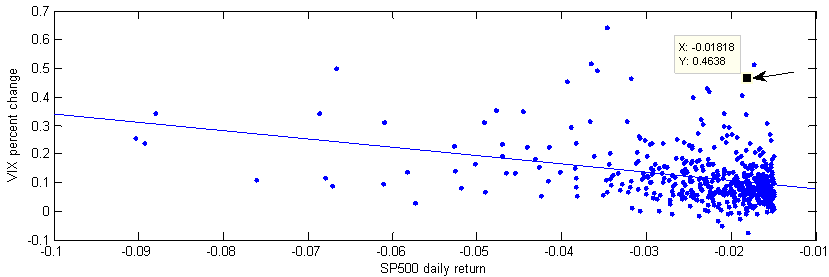Last Wednesday, the SP500 index went down by just -1.8%, but in the volatility space it felt like the world was going to end; the volatility term structure, as measured by the VIX/VXV ratio, reached 1, i.e. the threshold where it passes from the contango to backwardation state. The near inversion of the volatility term structure can also be seen on the VIX futures curve (although to a lesser degree), as shown below.

With only -1.8% change in the underlying SPX, the associated spot VIX went from 10.65 to 15.59, a disproportional increase of 46%. The large changes in the spot and VIX futures were also reflected in the prices of VIX ETNs. For example, SVXY went down by about 18%, i.e. 9 times bigger than the SPX return. We note that in normal times SVXY has a beta of about 3-4 (as referenced to SPY).
So was the spike in volatility normal and what happened exactly?
To answer these questions, we first looked at the daily percentage changes of the VIX as a function of SPX returns. The Figure below plots the VIX changes v.s. SPX daily returns. Note that we plotted only days in which the underlying SPX decreased more than 1.5% from the previous day’s close. The arrow points to the data point of last Wednesday.

A cursory look at the graph can tell us that it’s rare that a small change in the underlying SPX caused a big percentage change in the VIX.
To quantify the probability, we counted the number of occurrences when the daily SPX returns are between -2.5% and -1.5%, but the VIX index experienced an increase of 30% or greater. The data set is from January 1990 to May 19 2017, and the total sample size is 6900.
There are only 11 occurrences, which means that volatility spikes like the one of last Wednesday occurred only about 0.16% of the time. So indeed, such an event is a rare occurrence.
Table below presents the dates and VIX changes on those 11 occurrences.
| Date | VIX change |
| 23/07/1990 | 0.515 |
| 03/08/1990 | 0.4068 |
| 19/08/1991 | 0.3235 |
| 04/02/1994 | 0.4186 |
| 30/05/2006 | 0.3086 |
| 27/04/2010 | 0.3057 |
| 25/02/2013 | 0.3402 |
| 15/04/2013 | 0.432 |
| 29/06/2015 | 0.3445 |
| 09/09/2016 | 0.3989 |
| 17/05/2017 | 0.4638 |
But what happened and what caused the VIX to go up that much?
While accurate answers must await thorough research, based on other results (not shown) and anecdotal evidences we believe that the rise in the popularity of VIX ETNs, and the resulting exponential increase in short interest, has contributed greatly to the increase in the volatility of volatility.
We also note that from the Table above, out of the 11 occurrences, more than half (6 to be precise) happened after 2010, i.e. after the introduction of VIX ETNs.
With an increase in volatility of volatility, risk management became more critical, especially if you are net short volatility and/or you have a lot of exposure to the skew (dGamma/dSpot).

VIX measures settlement of options of spx. Returns is not a good factor to compare.
Thanks. Can you suggest a better factor?
Interesting. Would you say, that thanks to the VIX ETNs effect, it might be a good strategy to be long volatility in this low-volatility environment? I believe so, but the question is, how to be long volatility. Those ETNs are quite hard to trade, thanks to the contango effect.
Good question. I’d say that VIX ETNs and futures are now drivers of market volatility rather than fundamental. As how to exploit this, it’s a $2B question. I think buying vol still has negative expectancy, due to the contango, as you pointed out. However, if one has a large exposure to the equity markets, it’s better to hedge now by going long volatility. The hedge itself can still lose money, but it can protect the portfolio and hence enhance the risk-adjusted return. Also one might look into using VIX call options as a hedge, instead of SPX puts. The former might be cheaper.
I know a trader who uses this kind of hedge (buying/selling VIX call options) together with writing/buying calls on SPX. It sounds like a good idea. It’s a bit complex strategy, so one has to think about all the details.
It’s interesting, what you are saying. If SPX puts are a cheaper hedge then VIX call options and these two things are strongly correlated, doesn’t it mean that there is a possible arbitrage opportunity?
It leads to the strategy of the mentioned trader. Hmm…
If you think VIX calls are cheaper than SPX puts, then there is an arb. But as you said, the set up is complex, and you’re taking on correlation risks. Correlation can break down from time to time, so make sure you can handle the drawdown
WOW, If only there’s a way to analyze the write spx call & buy vix call trading scenario.